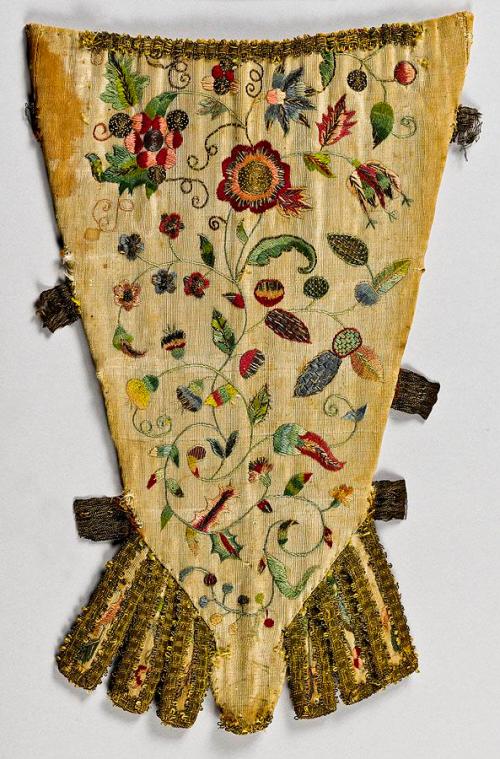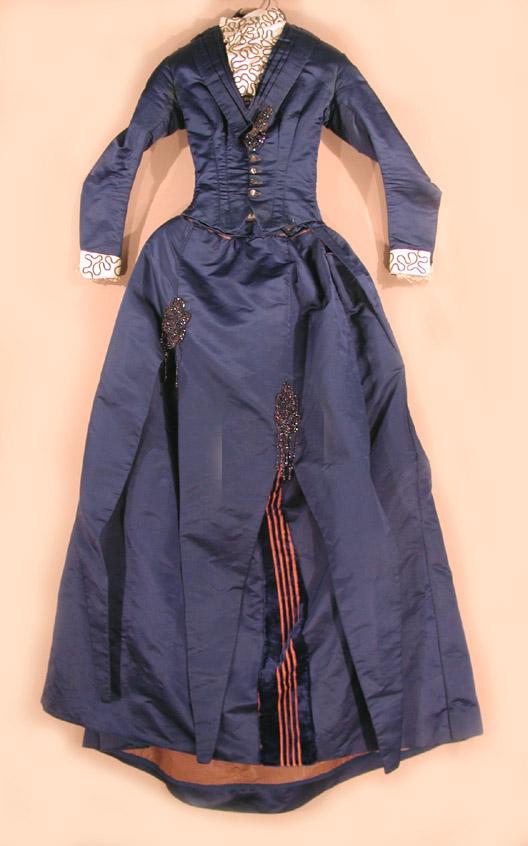Stomacher
Clothing MakerMade by
Unknown
Dateabout 1720-1740
MediumHand-stitched silk, with silk and metallic-thread embroidery and metallic braid; linen tapes, linen interlining, and reed (probably) boning
DimensionsPrimary Dimensions (length x width): 14 x 8 3/4in. (35.6 x 22.2cm)
ClassificationsCostume
Credit LineConnecticut Museum of Culture and History collection
Object number1950.20.0
DescriptionStomacher of cream-colored ribbed silk, embroidered in shades of green, pink, yellow, and blue silk and metallic threads with a design of grapes and stylized flowers blossoming on a slender, curling vine. There are six decorative tab extensions on the bottom of the stomacher; these are also made of the embroidered silk, and are edged with gold metallic braid. This metallic braid edges the top of the stomacher, also. The stomacher is roughly triangular in shape, with a two-inch extension forming a rounded point at the base; the length of this extension is equal to that of the decorative tabs. Under an interlining of linen, the stomacher is boned, probably with reed, as there is some flexibility to it. Short, linen tape tabs stitched on either side of the stomacher were used to pin the stomacher in place under the front edges of the gown bodice. The reverse of the stomacher is lined with plain-woven, undyed silk. There is an original eighteenth-century pin stuck in the back of one of the decorative tab extensions at the bottom of the stomacher.
Label TextA stomacher was an essential women’s accessory in the early to
mid-eighteenth century. Stomachers were attached to the front bodice
edges of stylish open robe gowns by pinning the tabs to the bodices. The
V-shape gave the illusion of a long torso and narrow waist; its stiff ness
encouraged an upright posture, forcing the wearer to bend at the hips,
rather than the waist.
The leaves and fl owers, as well as the combination of colors and patterns,
are fantastic rather than based on nature. Although the stitches are fairly
simple, the metallic and silk threads, and fabrics, were expensive imports.
NotesAttribution Note: The shape and style of the stomacher suggests that it was embroidered and constructed in Connecticut or possibly in England, around the second quarter of the eighteenth century. The design and workmanship of the embroidery indicates that it was done by an amateur, but it is charming in its design and use of color. According to family history, Captain Lemuel White purchased the silk in China, had it made into a stomacher in either England or the United States, and then gave the stomacher to his wife, Mary Wells White, in 1794. However, the stomacher is much earlier than the family history states, because women were no longer wearing stomachers on their gowns by the 1790s. (Bassett 3/28/2001)mid-eighteenth century. Stomachers were attached to the front bodice
edges of stylish open robe gowns by pinning the tabs to the bodices. The
V-shape gave the illusion of a long torso and narrow waist; its stiff ness
encouraged an upright posture, forcing the wearer to bend at the hips,
rather than the waist.
The leaves and fl owers, as well as the combination of colors and patterns,
are fantastic rather than based on nature. Although the stitches are fairly
simple, the metallic and silk threads, and fabrics, were expensive imports.
Status
Not on viewLieutenant William Augustus Wetmore
1887-1895










